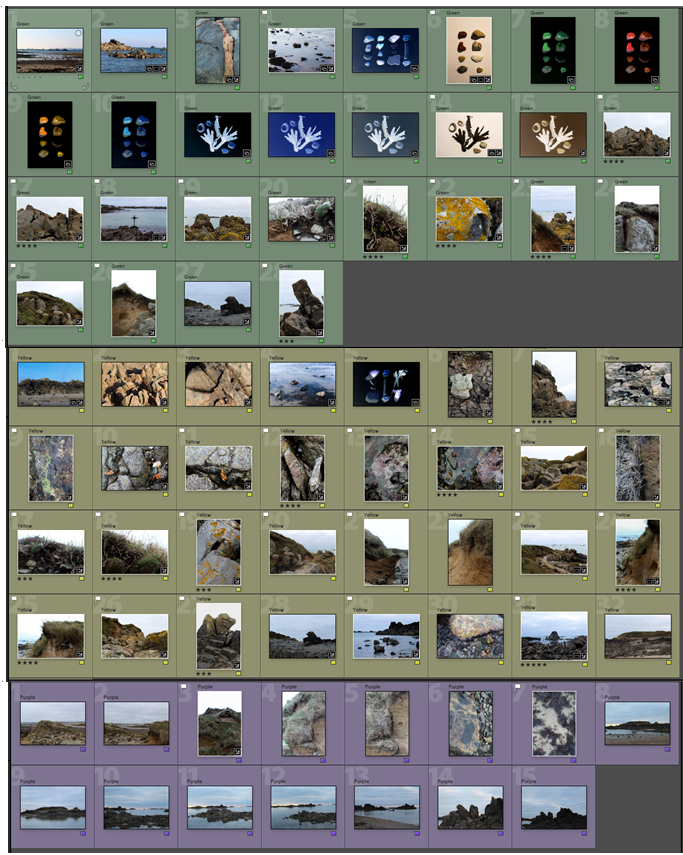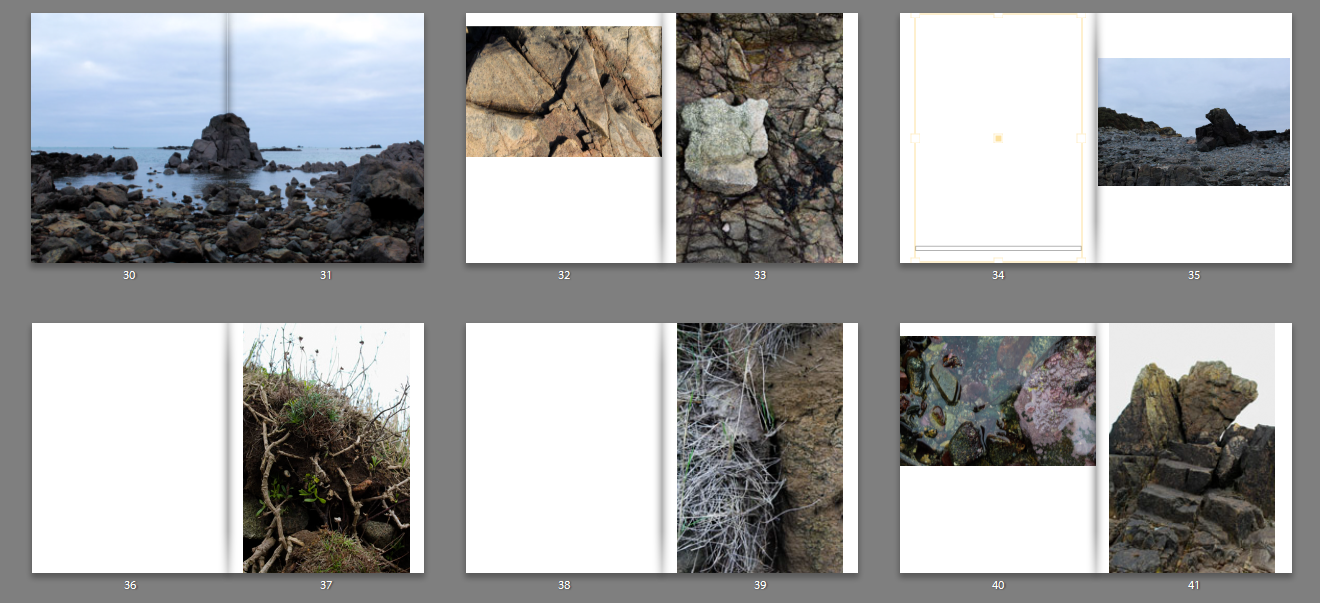
I first started selecting the images I wanted in my photo book by in lightroom by colour rating them into different colours if i wanted to use them. I had an idea of the images I definitely wanted to use in my photobook so rated them green. I then selected other images which I liked and rated them yellow and purple so I could experiment when designing my photobook in lightroom to see which made the best sequence and portrayed a message. This means that I won’t use all the images I’ve rated, but just the ones that combine to make the best photo series.
I then put all the images into a book format and started rearranging them from there instead of before making the book, so I could visually see what the image look like displayed together and which one complement each other. I want the sequence of my book to nt be too overwhelming because within the landscape images there is a lot of detail. To try and stop this i plan to add in double page spreads of single images between more detailed pages to create a break for the reader. This will also make the double paged images stand out more so I will chose images that I want to be emphasised.

I started my photo book layout by arranging my photos of objects i found on the beach that i formally photographed. I started with theses I knew definitely that i wanted to include these image in my photobook so didn’t have to make decisions about which ones to keep. I decided i wanted a similar layout to Chrystel Lebas in er ‘Field Studies’ book so displayed the original images on the left of the double page spread, with the four edited versions on the right page. I think this layout is effective as it shows the contrast between the originals and the edited versions. One aspect i could improve with these double page spreads are the original images as i don’t like how their is a noticeable border around there the colour of the paper contrasts with the white of the photo book paper. To fix this I made the images full page so that there wasn’t noticeable white borders around the edges.

I also started arranging my landscape photography, starting off by trying to find good combinations of images to go on double page spreads. I decided that i would chose a number of set templates for my photobook so it doesn’t look too unordered so it creates an order that’s easy to look through that has a continuous theme. I decided which images looked good as a double page spread and which looked better as single images. For example, the image taken in my ‘Landscapes at dusk’ shoot looks best as a double page because of its composition as well as the cool tones, the double page adding to the vastness.
Also, because i found myself taking images where the main subject is centered , I couldn’t include these as double page spreads as in my book some of the image in the middle will be cut because of how the book was made, unless the subject was big enough to not get cut off like in the image above. So for these image i had to find combinations with other portrait images to stick to the templates in chose to use which was one landscape and one portrait image on a double page.


When experimenting with layouts i found i like this combination of the archival image and my modern image as together they connect at the same points, creating the appearance of one image across the double page spread. I think that the contrast between the rounded shape of the image in the right in comparison the the image on the left where theres more detailed in the earth creates an interesting image. Although the image were not taken at the same location at La Motte (the archival image is of the island whereas mine is a close up of the rock nearby), I think that it creates a juxtaposition of different textures, the archival image is where the earth has fallen apart from the excavation which juxtaposes with the more smooth texture of the rock with the seaweed attached.
I also like how the difference between the archival and modern is emphases by the archival being in black and white compared to the coloured modern one. This makes the brown tones and the pale blue sky in the modern image stand out more. Although, i decided that i didn’t want to use the layout of these tow images together in my photobook as the layout in my book has a full page image together with another image with a white border, which this layout doesn’t follow so may look out of place. To fix this i could create more double pages like this, but i don’y have enough archival images that connect at the same points to my modern images to make enough page. I will use these images in my photobook, but separately with with different images complementing them.

For this layout, I narrowed the images down to two layouts that worked best with my image on the right side. The layout on the left has my image displayed full page, with an archival image of a skull on the left page. I think this this combination of images works well as the shape of the bright rock in my image resembles the shape of a skull and is a similar colour. This creates a link between the two image which I think makes a good layout, linking the past to the present. When editing I brightened the rock so it was more noticeable, which i think also makes the link more noticeable. I also like the contrast in the background of the two images. The archival image has a lack background as it’s a formally taken photo, this then contrast to the background of my image which is brown rocks, adding more detail to the image. The dark parts and shadows in my image link to the black background of the archival one, which i think makes them complement each other. There is also a mystery surrounding the archival image about who’s skull is displayed in the image as the skull belonged to somebody over 90 years ago, the rock also belonged to the land along time ago.
The second layout is another landscape image i took from a different shoot. In this shoot the lighting was different so the appearance of this rock different as it has warmer tones where the brown is emphasised with more yellow tones. This contrasts worth the image on the right where the warm tones are less noticeable, the town more darker. Another reason i think these images complement each other is they both have noticeable dark lines highlighting the shape and texture of the rock, linking them. The lines in each image are detailed, but have similar shapes to each other and the combination the two makes the layout seem more modern through he warm colours and the shapes resembling that of abstract, especially in the left image where i took a close up angle. Using this image also emphasises the highlights in the right image as it’s brighter.
Comparing the two layouts I decided that I will chose the layout comparing the skull to my image as i think it represent the concept of my project more. he archival image contrasting to the modern image addresses how the natural landscape changes an evolves over time.
Text in Book
La Motte is a tidal island, and listed archaeological site, also known as Green Island, located in the Vingtaine de Samarès in the parish of St Clement on the south-east coast of Jersey, Channel Islands.
Archaeological excavations carried out between 1911 and 1914 showed that the islet had been occupied over a long period of time. Despite being quite small the site is unusual because it had several both ritual and domestic elements, as well as providing important environmental evidence relating to changes in sea level. The remains of a series of prehistoric rubbish heaps, dating between 1,500-300 BC, containing fragments of pottery, animal bones, stone tools and shells were found.
Some archaeological evidence has been found here. Remains of a cemetery on La Motte are believed to be from later settlers. There are Neolithic elements including a cairn and a number of middens, dating from 1500 BC to 300 BC, on La Motte.
I think including text about La Motte gives the reader insight into the images their looking at as they might not know where ‘La Motte’ is as it’s more commonly known as Green Island. I also think that it reflect the work of Chrystel Lebas in her photobook ‘Field Studies’ as she also includes text about the places she visits. In her book she also includes 3 essays from others about the environment to back up her images. I decided not to include long passages in my photobook I didn’t want to take the attention of the readers away from the images, so included a few short passages to help inform them about the project, but not completely distract them away from the main concept.
